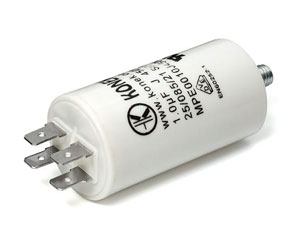
We will need to know some data about the motor, such as power and power factor, both indicated by the manufacturer, for example on the motor nameplate.
We have two types of capacitors according to the motor’s required operation:
- Running capacitor. The capacitor that is connected to the motor is designed for continuous operation, meaning that the capacitor will be working while the motor is running.
- Starting capacitor. The starting capacitor is designed for intermittent operation, meaning that it only operates at the moment of motor starting. Sometimes, we need a bit more force to start the motor, and that’s when the starting capacitor works.
If necessary, we can work with both capacitors installed, one capacitor will only work at startup while the other capacitor will work continuously.
If you want to see the characteristics of a capacitor, such as how to measure voltage or capacitance, or its behavior in different circuits, you can access this page: Condensador
1-What capacitance should the capacitor have?
To know the capacitance value in microfarads that we need for a capacitor and achieve an optimal operation (running) torque in a single-phase line, we must first know the data of the motor such as power, current, and voltage.
The power of the motor is usually obtained from the manufacturer’s specifications, for example on the motor nameplate. We will apply the formula and obtain the following data.
In this equation, the power can be obtained from the motor nameplate. The working voltage would be 230V for a single-phase system. The power factor should also be indicated by the motor manufacturer, with a common value for electric motors usually being 0.8 or 0.85. Finally, the current will be the value that we need to find out.
The following equation solves for current from the previous equation.
Where:
- P = The power of the motor, measured in kilowatts (kW), is also indicated on the motor nameplate.
- V = Voltage, measured in volts.
- I = The intensity is measured in amperes.
Once we know the intensity, we will solve for the inductive reactance:
Where:
- V = It is the supply voltage, in single-phase power supply, for example 230 Volts.
- I = The current is measured in amperes.
And finally, we will calculate the capacitance of the capacitor in microfarads.
Where:
- C = It is the capacitance of the capacitor and it is measured in farads.
- I = The intensity is measured in amperes.
- F = It is the frequency and it is measured in Hertz
The result of the capacitance of the capacitor in microfarads may not match the market value of a capacitor. In that case, the capacitor with the closest value in microfarads to the equation result should be selected.
In many cases, we can use the value obtained by calculating 70 microfarads per kilowatt of motor power. Usually, by using this simple rule of three, we can obtain the value of the capacitance of the starting capacitor and then look for a capacitor in the market that comes close to this value.
To determine the value of the capacitance of a starting capacitor, we would have to multiply 140 microfarads per kilowatt of motor power.
For example, a 2.2 kW motor could operate with a starting capacitor with a capacitance of 154 microfarads, since the calculation of 2.2 x 70 = 154.
2-How should the capacitor be connected to the motor coils?
Permanent running capacitor in star configuration
Permanent running capacitor in delta configuration
Starting and permanent running capacitor
Guten Tag Habe einen Kompressor Stern-Dreieck 230/400 V 7,0/4,1A 2,2 KW 1 Stufig 3 Zylinder
REF 4621-100-50 der Kompressor soll mit 230V laufen nur 1 Motor